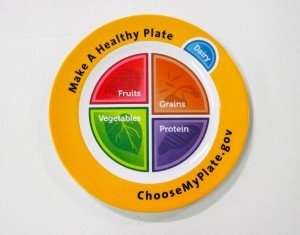Tender Fish, More Veggies
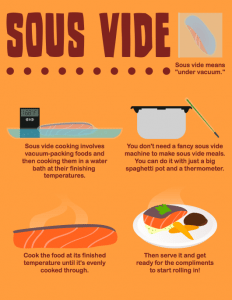 Freebie Alert: This post contains a free infographic!Now that summer is around the corner, it's time to start thinking about how you will provide wonderful summer meals filled with fresh veggies and fruits. Our garden is growing, the patio has its shade cover, and I am ready to venture outdoors again to cook and eat. Spring and summer are dearly loved in Colorado!I have been doing some adjunct teaching this past month, and during that time, I volunteered to help with a Modernist Dinner. Man, did I ever learn a lot about new cooking methods. If you follow me on Facebook, then you've probably already seen my quick video about how to use liquid nitrogen to make freeze-dried fresh basil. I also got to witness sous vide cooking with leeks and other foods.So of course I started experimenting with these methods in my own kitchen.I began with sous vide cooking. The translation for sous vide is "under vacuum." It means that you vacuum-pack your food, then cook it in water at the desired finishing temperature. In other words, you can cook fish at 160 degrees instead of blasting it on a 400 degree grill or drying it out in a 375 degree oven or pan-frying it in a lot of fat. The outcome with sous vide cooking is truly amazing.One of the best books for sous vide preparation is Under Pressure by Thomas Keller, chef/owner of the French Laundry. In case you are not familiar with this world-class restaurant, it's a 3-star Michelin restaurant located in Napa Valley, California. The average ticket is around $1000 per person. While most of us won't be going there anytime soon, we can learn a lot from Thomas Keller's philosophy and artistry, both of which are well-presented in his book. His dedication to delicious and perfectly-cooked food is inspiring.Under Pressure explores the technique of sous vide cooking with a variety of foods. For a restaurant chef or cook, sous vide is the answer to many prayers. With it, you can store food in a vacuum pack for a better shelf life. And you can also cook it in a vacuum pack food bag because the bags for packing are food safe (Boilable, Freezable, Reusable, Microwave Safe, Dishwasher Safe, BPA Free and FDA Approved).A steak can be cooked all day at its finished temperature. In other word, you could bag a steak in the morning and cook it in a sous vide machine for 10 hours at 145 degrees Fahrenheit and it would come out perfectly cooked all the way through. Then it's ready when you need it. Thomas Keller would even go so far as to sear the steak afterwards. That means that it would be cooked medium-rare all the way through, then browned on the outside. Gone are the days of searing the heck out of meats at super high temperatures, a dried product, and the resulting heterocyclic amines.We can adapt this philosophy and method at home, without the expensive traditional sous vide machines.Now I did order a simple consumer vacuum-packing machine along with food grade plastic. I understand that it's not as ideal as the commercial vacuum machines if you want to vacuum-pack food with liquids or oils, but this machine will pack fish, chicken, meat, and veggies by themselves (or with seasonings and a small amount of liquid or oil) just fine. I found that if I cooked something quickly in water at about 190 degrees, I did not need a fancy sous vide temperature-controlling circulating machine to cook my protein item for 10 hours. I can just use the big spaghetti pot in my kitchen with a thermometer. With this method, I made delicious fish that was ready in 20 minutes. Of course, if you had the fancier $900 machine you could cook it all day, putting your item on to cook and then taking it off later for company as they arrived.Here I have vacuum packed some Colorado trout that was on a store special for $2 per fillet! If I tried to grill these, even on foil, I know the outcome could never come close to what I served for dinner. My 18-year-old son, who is not particularly fond of fish, wolfed down his meal and said, "that is the best fish I have ever had."
Freebie Alert: This post contains a free infographic!Now that summer is around the corner, it's time to start thinking about how you will provide wonderful summer meals filled with fresh veggies and fruits. Our garden is growing, the patio has its shade cover, and I am ready to venture outdoors again to cook and eat. Spring and summer are dearly loved in Colorado!I have been doing some adjunct teaching this past month, and during that time, I volunteered to help with a Modernist Dinner. Man, did I ever learn a lot about new cooking methods. If you follow me on Facebook, then you've probably already seen my quick video about how to use liquid nitrogen to make freeze-dried fresh basil. I also got to witness sous vide cooking with leeks and other foods.So of course I started experimenting with these methods in my own kitchen.I began with sous vide cooking. The translation for sous vide is "under vacuum." It means that you vacuum-pack your food, then cook it in water at the desired finishing temperature. In other words, you can cook fish at 160 degrees instead of blasting it on a 400 degree grill or drying it out in a 375 degree oven or pan-frying it in a lot of fat. The outcome with sous vide cooking is truly amazing.One of the best books for sous vide preparation is Under Pressure by Thomas Keller, chef/owner of the French Laundry. In case you are not familiar with this world-class restaurant, it's a 3-star Michelin restaurant located in Napa Valley, California. The average ticket is around $1000 per person. While most of us won't be going there anytime soon, we can learn a lot from Thomas Keller's philosophy and artistry, both of which are well-presented in his book. His dedication to delicious and perfectly-cooked food is inspiring.Under Pressure explores the technique of sous vide cooking with a variety of foods. For a restaurant chef or cook, sous vide is the answer to many prayers. With it, you can store food in a vacuum pack for a better shelf life. And you can also cook it in a vacuum pack food bag because the bags for packing are food safe (Boilable, Freezable, Reusable, Microwave Safe, Dishwasher Safe, BPA Free and FDA Approved).A steak can be cooked all day at its finished temperature. In other word, you could bag a steak in the morning and cook it in a sous vide machine for 10 hours at 145 degrees Fahrenheit and it would come out perfectly cooked all the way through. Then it's ready when you need it. Thomas Keller would even go so far as to sear the steak afterwards. That means that it would be cooked medium-rare all the way through, then browned on the outside. Gone are the days of searing the heck out of meats at super high temperatures, a dried product, and the resulting heterocyclic amines.We can adapt this philosophy and method at home, without the expensive traditional sous vide machines.Now I did order a simple consumer vacuum-packing machine along with food grade plastic. I understand that it's not as ideal as the commercial vacuum machines if you want to vacuum-pack food with liquids or oils, but this machine will pack fish, chicken, meat, and veggies by themselves (or with seasonings and a small amount of liquid or oil) just fine. I found that if I cooked something quickly in water at about 190 degrees, I did not need a fancy sous vide temperature-controlling circulating machine to cook my protein item for 10 hours. I can just use the big spaghetti pot in my kitchen with a thermometer. With this method, I made delicious fish that was ready in 20 minutes. Of course, if you had the fancier $900 machine you could cook it all day, putting your item on to cook and then taking it off later for company as they arrived.Here I have vacuum packed some Colorado trout that was on a store special for $2 per fillet! If I tried to grill these, even on foil, I know the outcome could never come close to what I served for dinner. My 18-year-old son, who is not particularly fond of fish, wolfed down his meal and said, "that is the best fish I have ever had."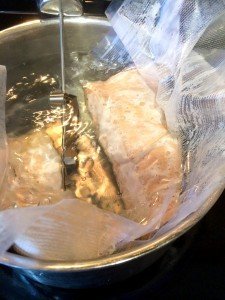 To go with the fish, I made a little low-fat mayonnaise with fresh chives from the garden and fresh lemon zest and juice.
To go with the fish, I made a little low-fat mayonnaise with fresh chives from the garden and fresh lemon zest and juice.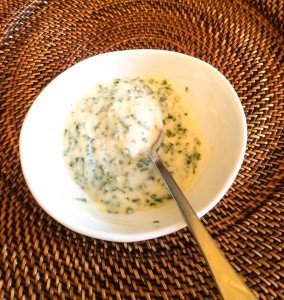 The grill held a variety of fresh veggies, including yellow sweet potatoes, zucchini, and yellow squash. We all scooped them right onto our plate after picking up the fish in the kitchen. The veggies were all cooked on foil with olive oil, garlic, and ginger.
The grill held a variety of fresh veggies, including yellow sweet potatoes, zucchini, and yellow squash. We all scooped them right onto our plate after picking up the fish in the kitchen. The veggies were all cooked on foil with olive oil, garlic, and ginger.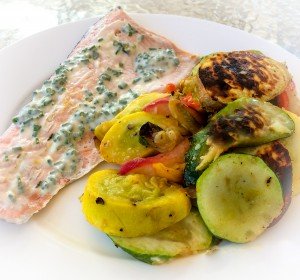 The great thing about poaching the fish in the kitchen is that the grill had a lot more room for veggies! We probably piled these too high for a fancy photo, but this really was our dinner, taken straight off the grill.Want to teach your clients about sous vide cooking? Get your copy of the free infographic today! Want to learn about safe cooking temperatures, click here.
The great thing about poaching the fish in the kitchen is that the grill had a lot more room for veggies! We probably piled these too high for a fancy photo, but this really was our dinner, taken straight off the grill.Want to teach your clients about sous vide cooking? Get your copy of the free infographic today! Want to learn about safe cooking temperatures, click here.  And there is always more in the Nutrition Education Store. Check out these amazing cooking resources...
And there is always more in the Nutrition Education Store. Check out these amazing cooking resources...


